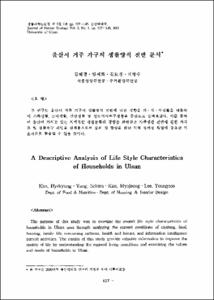측두엽간질 환자에서 보이는 정신병리의 특성
- Alternative Title
- Characteristics of Psychopathology in patients with Temporal Lobe Epilepsy
- Abstract
- The diagnostic tools and treatment modalities for epilepsies are growing in recent years. Therefore many investigators are studying the relationship of ipilepsy and psychopathology. These efforts are not only for the understanding of and therapeutic approach to psychiatric disorder in epileptic patients but also seeking the etiological basis of psychopathologies.
Method
45 patients who were diagnosed as temporal lobe epilepsy by brain MRI and EEG etc were investigated, and offered psychiatric diagnosis. Also we took detailed psychiatric histories and investigated the characteristic features of psychiatric disorders in temporal lobe epilepsy.
We evaluated several variables, i.e., age, sex, duration of epilepsy, age at first seizure, age at onset of epilepsy, time between first seizure and onset of epilepsy, seizure frequency, history of febrile convulsions, history of clustering seizures, and laterality of focus of these 45 subjects.
Futher investigations divided 45 subjects into a group without psychiatric disorder, a group with mood disorder and a group with psychotic disorder. And we compared those variables among these 3 groups.
Among 45 subjects, nine were diagnosed as psychotic disorders, five were mood disorders, and two were anxiety disorders. Among 9 subjects with psychotic disorders, six were diagnosed as psychotic disorder NOS, and the other three were schizophrenia. And they manifested unique clinical features in relations to epileptic seizures. Among 5 subjects with mood disorders, 4 subjects were diagnosed as dysthymia with chronic depression and 1 subject were major depression.
We compared all variables between the group without psychiatric disorder and the group with psychotic disorder however we can't find any statistically significant differences except one variable.
In the group with psychotic disorder, all subjects had the history of clustering of seizures in the rate of 100% of cases, but 54.6% of cases of the group without psychiatric disorder. The statistical difference was significant(p=0.016).
It is a preliminary study in this field in Korea. However this study will help to understand the various psychiatric symptoms of the patients with temporal lobe epilepsy and will help to promote further investigations in this field.
The diagnostic tools and treatment modalities for epilepsies are growing in recent years. Therefore many investigators are studying the relationship of ipilepsy and psychopathology. These efforts are not only for the understanding of and therapeutic approach to psychiatric disorder in epileptic patients but also seeking the etiological basis of psychopathologies.
Method
45 patients who were diagnosed as temporal lobe epilepsy by brain MRI and EEG etc were investigated, and offered psychiatric diagnosis. Also we took detailed psychiatric histories and investigated the characteristic features of psychiatric disorders in temporal lobe epilepsy.
We evaluated several variables, i.e., age, sex, duration of epilepsy, age at first seizure, age at onset of epilepsy, time between first seizure and onset of epilepsy, seizure frequency, history of febrile convulsions, history of clustering seizures, and laterality of focus of these 45 subjects.
Futher investigations divided 45 subjects into a group without psychiatric disorder, a group with mood disorder and a group with psychotic disorder. And we compared those variables among these 3 groups.
Among 45 subjects, nine were diagnosed as psychotic disorders, five were mood disorders, and two were anxiety disorders. Among 9 subjects with psychotic disorders, six were diagnosed as psychotic disorder NOS, and the other three were schizophrenia. And they manifested unique clinical features in relations to epileptic seizures. Among 5 subjects with mood disorders, 4 subjects were diagnosed as dysthymia with chronic depression and 1 subject were major depression.
We compared all variables between the group without psychiatric disorder and the group with psychotic disorder however we can't find any statistically significant differences except one variable.
In the group with psychotic disorder, all subjects had the history of clustering of seizures in the rate of 100% of cases, but 54.6% of cases of the group without psychiatric disorder. The statistical difference was significant(p=0.016).
It is a preliminary study in this field in Korea. However this study will help to understand the various psychiatric symptoms of the patients with temporal lobe epilepsy and will help to promote further investigations in this field.
- Issued Date
- 1995
- Type
- Research Laboratory
- Alternative Author(s)
- Kim, Chang-Yoon; Lee, Chul; Anh, Joon-Ho; Park, In-Ho; Han, Oh-Su
- Publisher
- 울산의대학술지
- Language
- kor
- Rights
- 울산대학교 저작물은 저작권에 의해 보호받습니다.
- Citation Volume
- 4
- Citation Number
- 2
- Citation Start Page
- 90
- Citation End Page
- 98
- Appears in Collections:
- Research Laboratory > The ULSAN university medical journal
- 파일 목록
-
-
Download
 000002024506.pdf
기타 데이터 / 1.49 MB / Adobe PDF
000002024506.pdf
기타 데이터 / 1.49 MB / Adobe PDF
-
Items in Repository are protected by copyright, with all rights reserved, unless otherwise indicated.